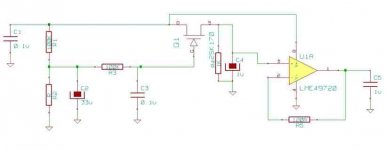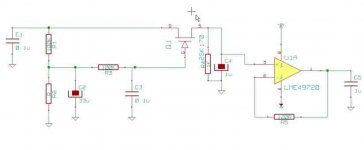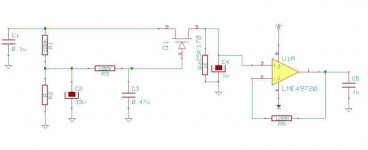Joshua, you should remove R4, it is unnecessary. It should get quieter as well.
Syn08, a friendly word of warning. You may be proud of your design, but the Vendetta SCP-1 or 2 design is quieter as a phono preamp, and the power supplies are quieter as well, than your submission here. I designed it about 25 years ago.
Syn08, a friendly word of warning. You may be proud of your design, but the Vendetta SCP-1 or 2 design is quieter as a phono preamp, and the power supplies are quieter as well, than your submission here. I designed it about 25 years ago.
john curl said:but the Vendetta SCP-1 or 2 design is quieter as a phono preamp, and the power supplies are quieter as well, than your submission here. I designed it about 25 years ago.
Possible, but can you substantiate with some numbers please?
just took a quick look; i agree with dimitri, isn't there a something missing to use Q1's source current to make a voltage?
mlloyd1
mlloyd1
dimitri said:Sorry Joshua, there might be some errors in your circuit. 🙁
You can find independent measurements of the SCP-2 on the 'Stereophile' website. However, 0.4nV/rt Hz was the nominal spec of the SCP-1 or SCP-2. It used 4 paralleled Toshiba devices, (equivalent to 8 2sk170 fets) operating at 12-15ma ea, pre-selected for less than 1.3nV/rt Hz at 10Hz. Much lower at 1KHz, measured with a Quantek Noise Analyzer Model 2173C.
In comparison, you have 3 paralleled 170's with a series 10 ohm resistance.
I have 8 paralleled 170's selected for very low 10Hz noise with a series 2.5 ohm resistance.
In comparison, you have 3 paralleled 170's with a series 10 ohm resistance.
I have 8 paralleled 170's selected for very low 10Hz noise with a series 2.5 ohm resistance.
syn08 said:
Possible, but can you substantiate with some numbers please?
Nevermind, I've found the Stereophile measurements results and spec http://www.stereophile.com/phonopreamps/640/index.html Here's the comparison (mostly measurements by J. Atkinson but some product spec were added):
------------------------------------Vendetta SCP-2---HPS 2.0
S/N 20-20k unweighted @0.5mV:------62.5dB-----------76dB
RIAA error:--------------------------------+/-0.1dB-------+/-0.15dB
THD @20kHz 5mV:-------------------------0.02%----------0.002%
IMD 19+20k:----------------------------------?---------------0.007%
MM Gain:-------------------------------------62dB------------64dB
Adjustable cartridge load:-----------------Yes--------------Yes
My target was to reach or exceed the Pass Xono performance, which I think I did (although with added complexity). Any comments?
john curl said:You can find independent measurements of the SCP-2 on the 'Stereophile' website. However, 0.4nV/rt Hz was the nominal spec of the SCP-1 or SCP-2. It used 4 paralleled Toshiba devices, (equivalent to 8 2sk170 fets) operating at 12-15ma ea, pre-selected for less than 1.3nV/rt Hz at 10Hz. Much lower at 1KHz, measured with a Quantek Noise Analyzer Model 2173C.
In comparison, you have 3 paralleled 170's with a series 10 ohm resistance.
I have 8 paralleled 170's selected for very low 10Hz noise with a series 2.5 ohm resistance.
I use 4x2SK170 (selected for 0.9nV/rtHz also matched) John, for a total of 26mA, take a better look. The noise is pretty much the 10ohm resistor noise. Care to explain why the SCP-2 has such poor measured S/N ratio? I'm not sure it's an apple to apple comparison. Xono uses 4x2SK170 and is close to my results (the difference is in 2SK170 selection criteria, I guess).
Also curious, how did you get that thing stable for more than 4 2SK170 in parallel, I suppose without gate resistors? For me, anything over 4 oscillates at over 100MHz, the greater Idss, the worse. That's where you may have something, otherwise simply paralleling more JFETs is pretty much a no brainer.
BTW, I purchased 300 2SK170 and found only 3 sets of 4 matching JFETs with about 0.9nV/rtHz. I use the same Quantec equipment.
syn08 said:
Also curious, how did you get that thing stable for more than 4 2SK170 in parallel, I suppose without gate resistors? For me, anything over 4 oscillates at over 100MHz, the greater Idss, the worse. That's where you may have something, otherwise simply paralleling more JFETs is pretty much a no brainer.
BTW, I purchased 300 2SK170 and found only 3 sets of 4 matching JFETs with about 0.9nV/rtHz. I use the same Quantec equipment.
I bought a bag of SMT ferrite beads to try. I know, THE HORROR, but still a worthy experiment.
BTW did you ever run the senario of picking FET's at random from a large distribution and letting them run at different currents? You would be surprised at how little the net gm (i.e. noise) differs from having a matched set. Even 4:1 Idss spread.
scott wurcer said:
I bought a bag of SMT ferrite beads to try. I know, THE HORROR, but still a worthy experiment.
BTW did you ever run the senario of picking FET's at random from a large distribution and letting them run at different currents? You would be surprised at how little the net gm (i.e. noise) differs from having a matched set. Even 4:1 Idss spread.
I was thinking myself about ferrites, i'll give it a shot ASAP.
Haven't tried mismatched JFETs, don't realy know why 😀
Happy New Year, Scott!
dimitri said:Sorry Joshua, there might be some errors in your circuit. 🙁
How about this one?
Attachments
remove C4 - it may cause oscillations of the follower
arrange the feedback network to isolate 1uF capacitive load - it also may cause instability
http://www.ecircuitcenter.com/Circuits/op_cload/op_cload.htm
http://www.audiodesignline.com/howto/206503221
I'll also make L3 C3 ten times larger, replace R2 with voltage reference and fed it from the output, also your opamp has 2.5uV/sqrtHz, while 2SK170 has 1uV/sqrtHz, I'll replace opamp with AD797
arrange the feedback network to isolate 1uF capacitive load - it also may cause instability
http://www.ecircuitcenter.com/Circuits/op_cload/op_cload.htm
http://www.audiodesignline.com/howto/206503221
I'll also make L3 C3 ten times larger, replace R2 with voltage reference and fed it from the output, also your opamp has 2.5uV/sqrtHz, while 2SK170 has 1uV/sqrtHz, I'll replace opamp with AD797

Re: Aluminum plate thickness?
Now we're talkin'! My kinda stuff.
audiowolf said:Current flow produces magnetic fields, magnetic fields induce current flow which induces currents ad on infinitum.....In the Newtonian world, this is involute. If you want to talk about what happens to EMR in a Bose-Einstein condensate, well that is another matter...a chilling subject to ponder, almost timeless in scope [ pun intended ]
Rocking the boat again,
Now we're talkin'! My kinda stuff.
Joshua_G said:
Indeed.
Now, I believe there is no question that a case of milled blocks of aluminum, like the one in Blowtorch, is the cr�me of the cr�me of SOTA audio.
I wish I could afford one for my DAC � but I cannot afford it.
So, financial considerations force me to move a step down, hopefully still remaining at SOTA level.
I believe next step down will be aluminum case made of separate 6 outer plates and some inner separation plates � or is there another option?
What would be the minimum thickness of aluminum plates for a case of medium budget project aimed at approaching SOTA audio gear?
Have at least an inch of space from any part of the circuit, including wiring -being near any aluminum, and use plastic stand-offs if necessary. Use a Teflon sheet (0.125") for the jack mounting area, and possibly for the control mounts (switches and pots) This, even for the power umbilical. I even bought a 36"x16ftx0.125" teflon sheet off ebay, got it for a song, comparatively speaking ($100). Had to make sure I have enough for any project that might pop up.
That'll get you close enough for horseshoes and handgrenades.
Harpy Screw Beer everybody!
Joshua_G said:Thank you, John.
How about this one?
Joshua,
"You have two more tries before self destruction."
You made my day!
Re: Re: Aluminum plate thickness?
The Heisenberg uncertainty principle still holds in a Bose-Einstein condensate, something to ponder as well as the fact that people everyone love to slam predicted this stuff how many years ago, with good old "obsolete" math and physics?
KBK said:
Now we're talkin'! My kinda stuff.
The Heisenberg uncertainty principle still holds in a Bose-Einstein condensate, something to ponder as well as the fact that people everyone love to slam predicted this stuff how many years ago, with good old "obsolete" math and physics?
Joshua_G we have problems with this schematic. We can go through it, piece by piece, but it is not optimum at this point. In fact it has too many parts, and is not too quiet.
What I was trying to point out with C3 is that it MUST be a low impedance at all audio frequencies in order to not see a significant fraction of the 100,000 ohm resistor noise. I would recommend 33 to 220 ohms in that position. As Dimitri pointed out, adding a large capacitor after the follower can make it oscillate, and it won't do much good. The IC is kind of noisy compared to the 2sk170, and maybe something else that has enough output current, but like 1nV/rt Hz or so would be more appropriate. In fact, you don't really need an IC at all, if you just parallel two 2sk170 devices to get more current.
What I was trying to point out with C3 is that it MUST be a low impedance at all audio frequencies in order to not see a significant fraction of the 100,000 ohm resistor noise. I would recommend 33 to 220 ohms in that position. As Dimitri pointed out, adding a large capacitor after the follower can make it oscillate, and it won't do much good. The IC is kind of noisy compared to the 2sk170, and maybe something else that has enough output current, but like 1nV/rt Hz or so would be more appropriate. In fact, you don't really need an IC at all, if you just parallel two 2sk170 devices to get more current.
- Status
- Not open for further replies.
- Home
- Amplifiers
- Solid State
- John Curl's Blowtorch preamplifier



